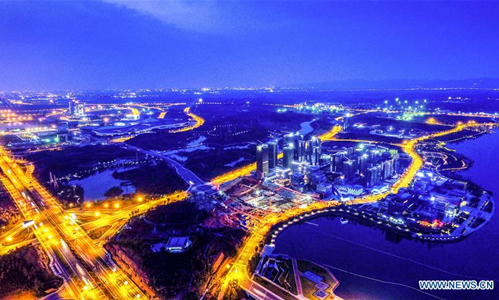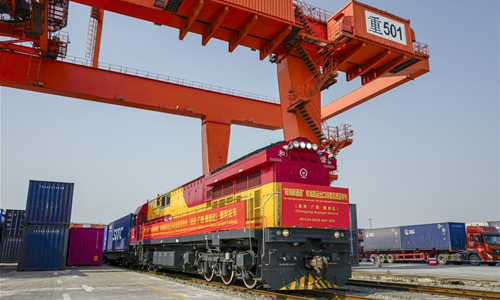Poverty rate dropped to 1.1% in western China's rural areas in 2019: NDRC
Source:Global Times Published: 2020/5/21 18:53:40

Aerial photo taken on April 22, 2017 shows buildings of a science city in Chengdu Tianfu New Area of China (Sichuan) Pilot Free Trade Zone (FTZ), southwest China's Sichuan Province. Photo: Xinhua
China's West Development strategy has seen huge achievements in the past 20 years, including economic progress, poverty alleviation, infrastructure construction and the protection of the ecological environment, an official of the National Development and Reform Commission (NDRC) said on Thursday.In addition to the regional benefit to people's livelihoods, an analyst said that the development of China's western region also benefits the world.
The official's interpretation came following the Sunday issuance of a guideline on advancing the development of China's western regions in the new era to promote coordinated regional development. The guideline will ensure that the western region builds a well-off society in an all-round way together with the rest of the country this year, according to the NDRC's official WeChat account on Thursday.
Since China put forward its West Development strategy over 20 years ago, the GDP of its 12 western provinces, autonomous regions and municipalities increased from 1.5 trillion yuan ($211.35 billion) in 1999 to 20.5 trillion yuan in 2019, accounting for 20.7 percent of the national GDP, an increase of 3.6 percentage points.
The number of poor people in China's rural western areas decreased from 50.86 million in 2012 to 3.23 million in 2019, and the poverty rate dropped from 17.5 percent to 1.1 percent. More than 90 percent of poverty-stricken counties in the western region had been lifted out of poverty by the end of 2019.
"The western region is located inland and is full of mountains, making it difficult for the region to exchange people and goods with other parts of China before infrastructure is completed," Tian Yun, vice director of the Beijing Economic Operation Association, told the Global Times on Thursday.
The construction of infrastructure in China's western region is now relatively complete after two decades of efforts. By 2019, it had a total railway length of 56,000 kilometers, including 9,630 kilometers of high-speed railway which connects most provincial capitals and more than 70 percent of major cities, according to the NDRC.
"The region was left behind the eastern areas in terms of economic development since China launched its reform and opening-up 40 years ago, as the eastern regions have easier connections with the world to facilitate trade. But the Belt and Road Initiative (BRI) contributed to the western region's rapid economic growth," said Tian.
Transportation has been improving due to the rising number of China-Europe freight trains since 2011. Trains have helped slash travel from Southwest China's Chongqing to Europe down to about 12 days, one-third of the time it take to ship goods by sea.
The BRI became a new driver for economic growth in the western region as its railways link China, Central Asia and Europe, Tian noted.

The land-sea freight train of the New International Land-Sea Trade Corridor heading for Indonesia waits to depart in southwest China's Chongqing, April 26, 2019. Photo: Xinhua
Southeast Asian countries also enjoy the benefits of the China-Europe freight trains, especially after Chongqing launched the China-Singapore rail-sea transit route in 2017, under a New International Land-Sea Trade Corridor linking China and ASEAN members.
By the end of 2018, freight trains had made 805 trips via the corridor, which links 155 ports in 71 countries and regions, the Xinhua News Agency reported.
Posted in: INDUSTRIES